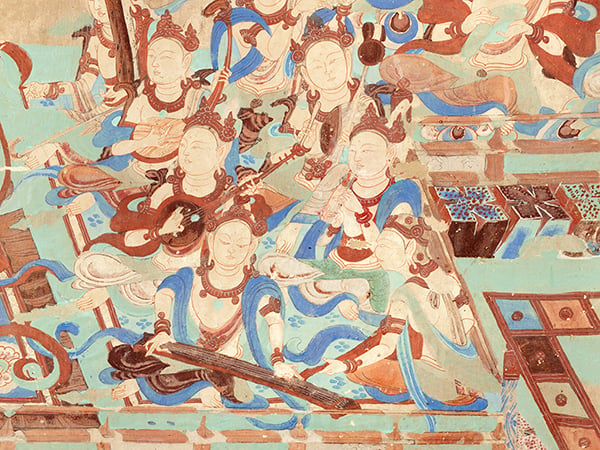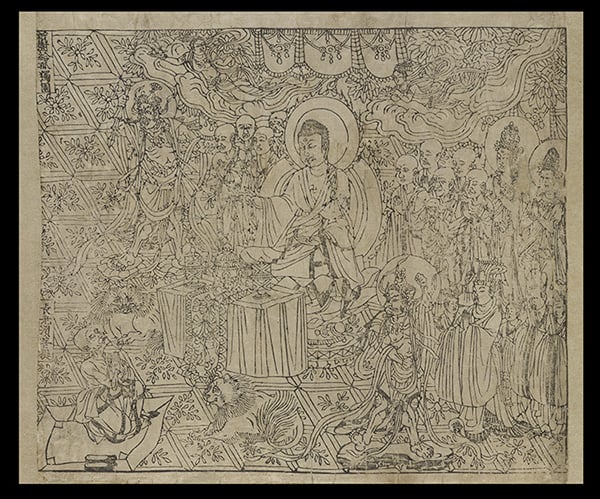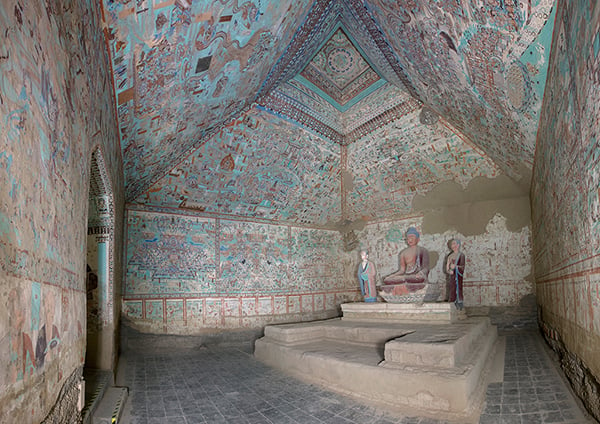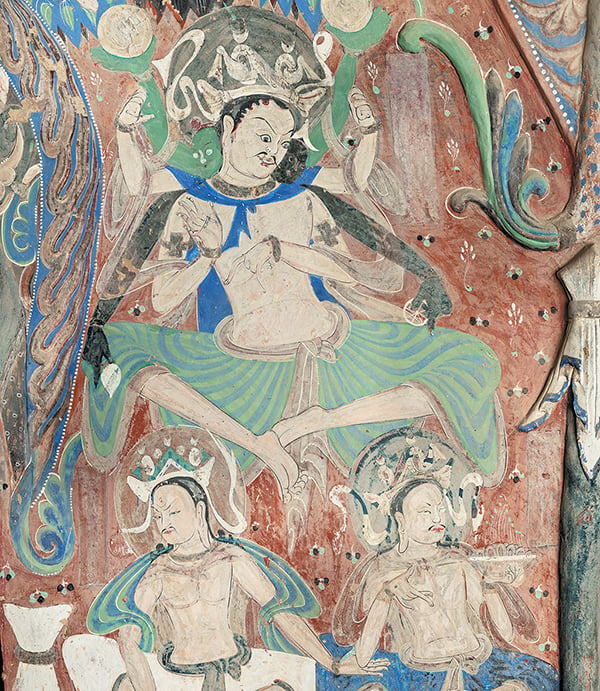Art & Exhibitions
A Walk Through the Getty’s Blockbuster Mogao Caves Exhibition with Mimi Gates
Gates lit a fire under a long-overdue project.

Gates lit a fire under a long-overdue project.

Maxwell Williams

“The Diamond Sutra is the world’s oldest dated complete printed book,” says Mimi Gardner Gates, fumbling only slightly on the tongue twister of an asterisk. She is prowling the Getty Research Institute Gallery, sharing her expertise on the texts and manuscripts of the Library Cave, one of the 492 Mogao Grottoes dug into the side of a rocky slab in the middle of the sandy carpets of the Gobi Desert’s Southern reaches.
Gates is the plucky catalyst behind the Getty’s tentpole summer exhibition “Cave Temples of Dunhuang: Buddhist Art on China’s Silk Road,” and her resonant voice is giving solid morsels of knowledge about the trove of 43 objects borrowed from institutions around the world. “Buddhism brought with it the idea of karma and rebirth,” says Gates, a silk handkerchief peeking out of her pocket. “Buddhism was the largest import into China, period. You would commission a painting, a cave, or do a ritual to gain merit and perhaps happiness in this life, perhaps a better rebirth for yourself or family members. The famous Diamond Sutra, dated 866, he did on behalf of his parents, who presumably were deceased, so that they would have a better rebirth.”
Tim Whalen, the director of the Getty Conservation Institute, credits Gates with lighting the fire under a project that was long overdue. The Getty had been working with Dunhuang Academy for nearly 30 years, helping restore and preserve the caves’ extensive paintings and sculptures made between the 4th century and the 14th century, when Dunhuang was an vital hub on the Silk Road. “But it wasn’t until Mimi got involved that the project really took off,” Whalen tells artnet News at the recent press preview. “It really got going about four years ago.”
The 43 Library Cave objects are just one part of a three-pronged exhibition that also includes three replica caves—two of which were crafted specifically for the Getty exhibition by Dunhuang replica cave makers—that were shipped and flown over from the Dunhuang Academy. The final part of the show is a 3-D stereoscopic images of Cave 45, not unlike Werner Herzog’s documentary about the Chauvet Caves, Cave of Forgotten Dreams (minus the gentle, abstruse Herzog-ian narration).

Diamond Sutra, 868 CE, ink on paper. British Library, London. © The British Library Board.
Dunhuang came into the purview of Gates—who is married to William H. Gates, Sr. (father of Microsoft founder Bill Gates)—in the early ’80s when she was earning a PhD in Chinese art history at Yale, but it was as the director of the Seattle Art Museum (SAM) in 1995 that she finally made it to the Mogao Caves. “The first time I walked into the caves, I was just completely overwhelmed,” she says.
As soon as Gates left SAM in 2009, she was asked by Dunhuang to return to the caves and give a presentation on visitor experience. From that moment on, she was hooked. “It’s so rich, and it’s so complex, and you’re always finding new perspectives,” she says. “But what I think is so spectacular about it is the intersection of cultures. This is a site where Greek and Roman, Persian and Middle Eastern, Indian and Chinese cultures intersected over a millennium until the 14th century. There just is not another site like it.”
Now Gates is the chairman of the Dunhuang Foundation, and sits on the board of the Friends of Dunhuang with Neville Agnew, the project specialist at the Getty who has been working between Dunhuang and LA for many years. Along with Marcia Reed, chief curator at the Getty Research Institute, and Fan Jinshi, director emerita of the Dunhuang Academy, Agnew and Gates are the lead curators of the current exhibition.
What Gates delights in most is the take that the Mogao Caves are the epicenter of a pre-modern globalized region, where dozens of different cultures collided. “Dunhuang shows that it was a global age until the 14th century,” Gates tells me. “Not only were they Chinese, but they were Uyghurs, Sogdians, Persians, Turkic peoples, Tibetans. Dunhuang was a thriving metropolis.”

Cave 85, view of the interior, Late Tang dynasty (848–907 CE). Mogao Grottoes, Dunhuang, China. Courtesy the Dunhuang Academy.
Later, that idea is resurrected during the press conference, when Zhihang Chi from airline sponsor Air China will quip that Thomas Gaehtgens, director of the Getty Research Institute, taught him China invented globalization. “The whole time I thought it was an idea of Bill Clinton,” he says to laughter.
The 1:1 scale replica caves—Cave 285 (sixth century), and Cave 320 (eighth century)—took nearly four years to meticulously craft before being brought over to the Getty (Cave 275 from the fifth century was already built and has visited many sites around the world). Fake cracks and patches where floods washed away the paintings are replicated perfectly, and they show the challenges to keeping the Mogao Caves in good condition. Replication is a big part of the Dunhuang tradition, Gates tells me. “It was a way of gaining karma,” she says.
This tradition of replication gives the replica caves a bit more credence than, say, the “faux Chauvet” or the replica Lascaux that France has promoted. Still, one can’t help but fantasize about visiting the actual Mogao Caves, no matter how distant they are.

Cave 285, detail of wall painting, Western Wei dynasty (535–556 CE). Mogao Grottoes, Dunhuang, China. Courtesy the Dunhuang Academy.
But there are some incredible artifacts to see at the Getty. Back in the Library Caves archives, which were found when a monk named Wang Yuanlu stumbled upon a hidden room in one of the cave-temples in late 19th century after being sealed for nearly a century, there are Jewish and Christian texts written in Chinese, Buddhist texts in Tibetan, texts in Sanskrit, altar diagrams, paintings, textiles, and important sutras. Most of the items were snatched up by European explorers Aurel Stein and Paul Pelliot and distributed throughout Europe.
Together, says Gates, they offer a glimpse into another time and another culture, particularly one that harkens back to a cosmopolitan society that we don’t often acknowledge, and offers lessons that we sometimes forget. Maybe, says Gates, the people of Dunhuang were ahead of their time in their open-mindedness. “All too often we dismiss things, because they’re strange to us, but something like the beauty of these paintings, trying to understand Buddhism and its inclusiveness, the idea that you can accept things that are strange to you, and be surprised, and that opens up a new perspective on the world,” says Gates.
“Cave Temples of Dunhuang: Buddhist Art on China’s Silk Road” will be on view at the Getty Research Institute and Getty Conservation Institute, May 7–September 4, 2016.